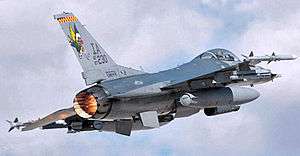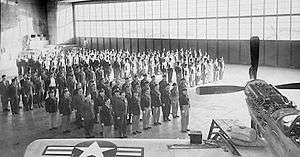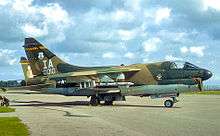124th Attack Squadron
The 124th Attack Squadron is a unit of the Iowa Air National Guard 132d Wing. It is assigned to Des Moines International Airport (Des Moines ANGB), Iowa and was formerly equipped with F-16 Fighting Falcon aircraft. The unit is reequipping with the MQ-9 Reaper.
| 124th Attack Squadron | |
|---|---|
 124th Fighter Squadron F-16 87-230 | |
| Active | 25 February 1941-Present |
| Country | |
| Allegiance | |
| Branch | |
| Type | Squadron |
| Role | Attack |
| Part of | Iowa Air National Guard |
| Garrison/HQ | Des Moines International Airport, Iowa |
| Nickname(s) | "Hawkeyes" |
| Tail Code | Red & Yellow (checkerboard) tail stripe "IA" |
| Engagements | World War II |
| Insignia | |
| 124th Fighter Squadron emblem (approved 8 October 1952)[1] |  |
| 124th Observation Squadron emblem[2] |  |
The squadron is a descendant organization of the 124th Observation Squadron, established on 30 July 1940. It is one of the 29 original National Guard Observation Squadrons of the United States Army National Guard formed before World War II.
History
World War II
Efforts to form an Iowa National Guard aviation unit in Des Moines were led by a citizens' committee, which was formed in May 1940, to arrange for construction of an aircraft hangar and armory building at the Des Moines Airport. This non-profit committee consisted of local business, civic and military leaders. Through the work of this committee, which included conferences in Washington DC, and design and financing of the project, an Air Corps squadron for Des Moines was authorized by President Franklin D. Roosevelt in January 1941. Recruiting of members for the new unit began the following month. The 124th Observation Squadron was organized on 25 February 1941 with an allotted strength of 31 officers and 116 enlisted personnel.
The 124th was a light observation squadron, flying North American O-47 twin-seat observation monoplanes. Ordered to active service in September was initially an aviation unit at Fort Leavenworth, Kansas as part of the U.S. Army Command and General Staff College. After the Japanese Attack on Pearl Harbor, was attached to Army Air Forces Antisubmarine Command and deployed to several airfields along the Texas and Louisiana Gulf Coast, flying Antisubmarine patrols, Apr 1942 – Jan 1943. After the Navy took over the antisubmarine mission performed replacement reconnaissance pilot training, Mar 1943 – Apr 1944 at Tullaholma, Tennessee with P-39 Airacobra, P-40 Warhawk and P-51 Mustangs. Inactivated as part of an administrative reorganization of training units in May 1944.
Iowa Air National Guard

Was transferred to the new Iowa Air National Guard in May 1946 and became a P-51D Mustang squadron, receiving federal recognition on 23 August 1946, one of the first Air National Guard squadrons activated. Assigned to Des Moines Municipal Airport, a former training field during World War II used as an Aircraft/Crew processing center for heavy bomber crews. Was assigned to the Iowa ANG 132d Fighter Wing, which consisted of the 124th, along with the 127th Fighter Squadron at Sioux City, and the Nebraska ANG 173d Fighter Squadron at Lincoln, Nebraska. Engaged in routine training exercises, and was upgraded to F-84B Thunderjet jet aircraft in early 1948.
Activated to Federal Service during the Korean War, sent to Dow AFB, Maine Used by TAC to train replacement pilots in F-51D Mustang ground support operations, also deployed unit members to Japan and Korea to fly combat missions.

The 132d was moved to Alexandria AFB, Louisiana in May 1952 again with F-51s replacing the federalized Oklahoma ANG 137th Fighter-Bomber Wing which was deployed to France. Performed training as a tactical fighter unit until relieved from active service and returned to Iowa ANG jurisdiction in January 1953.
During 1952, over one million dollars of federally funded improvements were added to the Des Moines airport. The work included the addition of 1,800 feet to the main runway and 3,480 feet of taxiways to better accommodate the 124th receiving jet aircraft upon their return to peacetime service. After returning to Des Moines, was re-equipped with F-80C Shooting Star jet fighter-bombers and returned to normal peacetime training committed to Tactical Air Command. Was later upgraded to newer F-84E Thuderjets in 1955. Was transferred to Air Defense Command in July 1958, becoming an all-weather F-86L Sabre Interceptor squadron, its new mission being the air defense of Des Moines and eastern Iowa. The Sabres were replaced in 1962 with F-89J Scorpion Interceptors, which the squadron flew until the summer of 1969.
Was transferred back to TAC in 1969, being re-equipped with second-line F-84F Thunderstreaks, the standard TAC aircraft for its Air National Guard-gained squadrons at the time. Upgraded to the F-100D Super Sabre, which were returning from South Vietnam in 1971 and being transferred to the ANG to replace the subsonic F-84s. Began receiving new and transferred A-7D Corsair II ground attack aircraft in 1976 when the National Guard Bureau began modernizing the ANG with frontline aircraft after the drawdown of the regular Air Force after the end of the Vietnam War.
Modern era

With the retirement of the A-7Ds in the late 1980s, was upgraded to Block 42 F-16C Fighting Falcons in 1990. From 1998 to 2004 as part of the Air Expeditionary Force concept with an unprecedented six overseas contingency deployments to patrol the No-Fly Zone over Iraq in Operations Northern and Southern Watch. Two of the six contingency deployments occurred within a ten-month period, attesting to the unit’s professionalism and high state of readiness.
Immediately following the events of September 11, 2001, the 124th Fighter Squadron's F-16s, pilots, and maintenance members were placed on alert, poised to defend Iowans and all Americans against any possible attacks. After 9/11 the unit’s F-16s were prepared to launch within minutes in the event of a “scramble” order – 24/7. The unit has also provided continuous Combat Air Patrols during Presidential visits.
The unit deployed to Al Udeid AB, Qatar in 2005 in support of Operation Enduring Freedom and Operation Iraqi Freedom. The squadron performed in an exceptional manner, exhibiting an impressive array of capabilities. Outstanding leadership and superb aircraft maintenance skills produced 456 sorties and 3145 flying hours in austere conditions. Total flying hours during this contingency equaled to over three-fourths of a year’s normal flying allocation in only 52 days.
In 2013, the 124th's 21 F-16s were transferred to the 119th Fighter Squadron, 177th Fighter Wing, New Jersey Air National Guard, at Atlantic City Air National Guard Base, bringing to an end 72 years of manned flight by the 124th.[3]
The squadron is re-equipping with the MQ-9 Reaper unmanned aerial vehicle, and was redesignated the 124th Attack Squadron after 2016.
Operations and Decorations
- Combat Operations: World War II
- Campaigns:
- Antisubmarine patrols, Apr 1942 – Jan 1943
- Operation Northern Watch
- Operation Southern Watch
- Operation Enduring Freedom
- Operation Iraqi Freedom
Lineage
- Designated 124th Observation Squadron and allotted to Iowa NG on 30 Jul 1940
- Activated on 25 Feb 1941
- Ordered to active service on 15 Sep 1941
- Re-designated: 124th Observation Squadron (Light) on 13 Jan 1942
- Re-designated: 124th Observation Squadron on 4 Jul 1942
- Re-designated: 124th Reconnaissance Squadron (Fighter) on 2 Apr 1943
- Re-designated: 124th Tactical Reconnaissance Squadron on 11 Aug 1942
- Disbanded on 1 May 1944
- Reconstituted 124th Fighter Squadron and allotted to the Iowa ANG on 24 May 1946
- Extended Federal recognition on 23 Aug 1946
- Ordered into active service on 1 April 1951
- Re-designated: 124th Fighter-Bomber Squadron in June 1952
- Relieved from active duty and returned to Iowa ANG, on 1 Jan 1953
- Re-designated: 124th Fighter-Interceptor Squadron on 1 Jul 1958
- Re-designated: 124th Tactical Fighter Squadron on 2 Aug 1969
- Re-designated: 124th Fighter Squadron on 15 Mar 1992
Assignments
- Iowa National Guard, 25 Feb 1941
- II Air Support Command, 15 Sep 1941
- 72d Observation Group, 26 Sep 1941
- 75th Observation (later Reconnaissance; Tactical Reconnaissance) Group, 12 Mar 1942 – 1 May 1944
- Attached to: I Bomber Command, 3 Jul-15 Oct 1942
- Attached to: AAF Antisubmarine Command, 15 Oct2 – 20 Nov 1942
- Attached to: 26th Antisubmarine Wing, 20 Nov 1942 – 4 Jan 1943
- 132d Fighter Group, 23 Aug 1946
- 132d Fighter-Bomber Group, on 1 Jan 1953
- 132d Fighter-Interceptor Group, 1 July 1958
- 132d Tactical Fighter Group, 1 July 1969
- 132d Fighter Group, 15 Mar 1992
- 132d Fighter Wing, 1 Oct 1995–present
Stations
|
|
Aircraft
|
|
See also
- List of United States Army National Guard Observation Squadrons
References
- Notes
- Maurer, Combat Squadrons, p. 349
- Hubbard, p. 120
- http://www.radioiowa.com/2013/08/22/iowas-f-16s-bound-for-new-jersey/
Bibliography
![]()
- Maurer, Maurer, ed. (1983) [1961]. Air Force Combat Units of World War II (PDF) (reprint ed.). Washington, DC: Office of Air Force History. ISBN 0-912799-02-1. LCCN 61060979. Retrieved 17 December 2016.
- Maurer, Maurer, ed. (1982) [1969]. Combat Squadrons of the Air Force, World War II (PDF) (reprint ed.). Washington, DC: Office of Air Force History. ISBN 0-405-12194-6. LCCN 70605402. OCLC 72556. Retrieved 17 December 2016.
- Hubbard, Gerard (June 1943). "Aircraft Insignia, Spirit of Youth". Vol. LXXXIII (No. 6) National Geographic, pp. 710–722
- Rogers, Brian. (2005). United States Air Force Unit Designations Since 1978. Hinkley, UK: Midland Publications. ISBN 1-85780-197-0.


